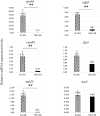High sporulation and overexpression of virulence factors in biofilms and reduced susceptibility to vancomycin and linezolid in recurrent Clostridium [Clostridioides] difficile infection isolates
- PMID: 31365590
- PMCID: PMC6668830
- DOI: 10.1371/journal.pone.0220671
High sporulation and overexpression of virulence factors in biofilms and reduced susceptibility to vancomycin and linezolid in recurrent Clostridium [Clostridioides] difficile infection isolates
Abstract
Clostridium [Clostridioides] difficile infection (CDI) is one of the leading causes of diarrhea associated with medical care worldwide, and up to 60% of patients with CDI can develop a recurrent infection (R-CDI). A multi-species microbiota biofilm model of C. difficile was designed to evaluate the differences in the production of biofilms, sporulation, susceptibility to drugs, expression of sporulating (sigH, spo0A), quorum sensing (agrD1, and luxS), and adhesion-associated (slpA and cwp84) pathway genes between selected C. difficile isolates from R-CDI and non-recurrent patients (NR-CDI). We obtained 102 C. difficile isolates from 254 patients with confirmed CDI (66 from NR-CDI and 36 from R-CDI). Most of the isolates were biofilm producers, and most of the strains were ribotype 027 (81.374%, 83/102). Most C. difficile isolates were producers of biofilm (100/102), and most were strongly adherent. Sporulation was higher in the R-CDI than in the NR-CDI isolates (p = 0.015). The isolates from R-CDI patients more frequently demonstrated reduced susceptibility to vancomycin than isolates of NR-CDI patients (27.78% [10/36] and 9.09% [6/66], respectively, p = 0.013). The minimum inhibitory concentrations for vancomycin and linezolid against biofilms (BMIC) were up to 100 times and 20 times higher, respectively, than the corresponding planktonic MICs. Expression of sigH, spo0A, cwp84, and agrD1 was higher in R-CDI than in NR-CDI isolates. Most of the C. difficile isolates were producers of biofilms with no correlation with the ribotype. Sporulation was greater in R-CDI than in NR-CDI isolates in the biofilm model of C. difficile. The R-CDI isolates more frequently demonstrated reduced susceptibility to vancomycin and linezolid than the NR-CDI isolates in both planktonic cells and biofilm isolates. A higher expression of sporulating pathway (sigH, spo0A), quorum sensing (agrD1), and adhesion-associated (cwp84) genes was found in R-CDI than in NR-CDI isolates. All of these factors can have effect on the recurrence of the infection.
Conflict of interest statement
The authors have declared that no competing interests exist.
Figures

Similar articles
-
Outcome of relapsing Clostridium difficile infections do not correlate with virulence-, spore- and vegetative cell-associated phenotypes.Anaerobe. 2015 Dec;36:30-8. doi: 10.1016/j.anaerobe.2015.09.005. Epub 2015 Sep 25. Anaerobe. 2015. PMID: 26403333
-
Multiple factors modulate biofilm formation by the anaerobic pathogen Clostridium difficile.J Bacteriol. 2013 Feb;195(3):545-55. doi: 10.1128/JB.01980-12. Epub 2012 Nov 21. J Bacteriol. 2013. PMID: 23175653 Free PMC article.
-
An in silico evaluation of treatment regimens for recurrent Clostridium difficile infection.PLoS One. 2017 Aug 11;12(8):e0182815. doi: 10.1371/journal.pone.0182815. eCollection 2017. PLoS One. 2017. PMID: 28800598 Free PMC article.
-
Clostridioides difficile Biology: Sporulation, Germination, and Corresponding Therapies for C. difficile Infection.Front Cell Infect Microbiol. 2018 Feb 8;8:29. doi: 10.3389/fcimb.2018.00029. eCollection 2018. Front Cell Infect Microbiol. 2018. PMID: 29473021 Free PMC article. Review.
-
Clostridium difficile Biofilm.Adv Exp Med Biol. 2018;1050:97-115. doi: 10.1007/978-3-319-72799-8_7. Adv Exp Med Biol. 2018. PMID: 29383666 Review.
Cited by
-
Analyses of publicly available Hungatella hathewayi genomes revealed genetic distances indicating they belong to more than one species.Virulence. 2021 Dec;12(1):1950-1964. doi: 10.1080/21505594.2021.1950955. Virulence. 2021. PMID: 34304696 Free PMC article.
-
RelQ-mediated alarmone signalling regulates growth, stress-induced biofilm formation and spore accumulation in Clostridioides difficile.Microbiology (Reading). 2024 Jul;170(7):001479. doi: 10.1099/mic.0.001479. Microbiology (Reading). 2024. PMID: 39028551 Free PMC article.
-
Genetic Mechanisms of Vancomycin Resistance in Clostridioides difficile: A Systematic Review.Antibiotics (Basel). 2022 Feb 16;11(2):258. doi: 10.3390/antibiotics11020258. Antibiotics (Basel). 2022. PMID: 35203860 Free PMC article. Review.
-
Characterization of community-acquired Clostridioides difficile strains in Israel, 2020-2022.Front Microbiol. 2023 Dec 19;14:1323257. doi: 10.3389/fmicb.2023.1323257. eCollection 2023. Front Microbiol. 2023. PMID: 38169783 Free PMC article.
-
Biofilm regulation in Clostridioides difficile: Novel systems linked to hypervirulence.PLoS Pathog. 2021 Sep 9;17(9):e1009817. doi: 10.1371/journal.ppat.1009817. eCollection 2021 Sep. PLoS Pathog. 2021. PMID: 34499698 Free PMC article. Review.
References
-
- McFarland LV, Elmer GW, Surawicz CM. Breaking the cycle: treatment strategies for 163 cases of recurrent Clostridium difficile disease. Am J Gastroenterol. 2002;97(7):1769–75. - PubMed
-
- Mac Aogain M, Moloney G, Kilkenny S, Kelleher M, Kelleghan M, Boyle B, et al. Whole-genome sequencing improves discrimination of relapse from reinfection and identifies transmission events among patients with recurrent Clostridium difficile infections. J Hosp Infect. 2015;90(2):108–16. 10.1016/j.jhin.2015.01.021 - DOI - PubMed
Publication types
MeSH terms
Substances
LinkOut - more resources
Full Text Sources
Medical
Molecular Biology Databases

